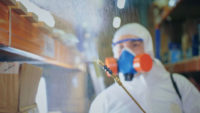COVID-19 cases are on the rise in many areas of the United States1, so it’s a good time to evaluate your personal protective equipment (PPE) protocol to help ensure workers are properly protected on the job and not bringing potential toxins home with them.
The Centers for Disease Control and Prevention describes take-home toxins as any hazardous substances that a worker might unknowingly bring home with them from the jobsite.2,3 Once in their home or car, these toxins can be spread to family members and cause a variety of health effects.2
Steps are important
The donning (putting on) and doffing (removing) processes are common steps where contamination unwittingly happens.
It’s important to don PPE correctly for on-the-job protection, but it’s equally important to doff PPE carefully so that your skin or street clothing aren’t cross-contaminated with any toxins you may have encountered during your shift.
Donning and doffing procedures may differ depending on the specific applications for your PPE. Please make sure to follow the standard operating procedures established for your workplace.
The essentials of proper donning
Donning, or putting on, a protective coverall correctly is instrumental to the performance of the garment. Once the appropriate coverall has been chosen, a contamination-free changing room should be made available away from the workplace for workers to get dressed.
- Find a safe place to sit and confirm proper garment size before beginning.
- While sitting, put protective foot covers (if used) over your footwear and secure
- Carefully put each foot into the legs of the coverall.
- Put on and securely lace your safety shoes or boots, if required for your application.
- Put on the correct gloves for your application.
- If using two sets of gloves, put on only the first set now.
- Stand up and pull the coverall up to your waist.
- Place your arms into the sleeves.
- Before zipping the coverall fully, put on any eye protection or protective masks you’ll be wearing.
- Ensure eye protection and masks fit correctly, are comfortable, and contain no gaps.
- Pull the hood over your head.
- Fully zip the coverall and push the zipper down to lock.
- If wearing a second pair of gloves, put the second pair on over the first pair, covering the coverall’s wrist and sleeves.
- Seal all gaps and joints with adhesive tape, including the ends of the gloves and around the face where the hood meets the mask.
- Folding a tab on the end of the tape will make it easier to remove during doffing
- Have a colleague confirm that the suit is donned correctly and that all gaps are sealed.
Proper steps when doffing
Removing protective gear should be done with great care so there is no accidental cross-contamination from the garment’s surface to the wearer’s skin or hair or to other employees. Having an assistant during the doffing process can further ensure the proper steps are followed.
- Find a safe place to remove gear.
- Before taking off the protective clothing, it’s advised to clean the gloves and boots, if applicable, in order to prevent dust and other toxins from being released into the air. Masks and zip covers should be wiped clean too.
- Carefully remove adhesive tape from coverall and immediately dispose of it into a specified waste container provided for this purpose.
- After removing the outer pair of gloves (if used), the wearer (or assistant) should begin by unzipping the coverall
- Next, carefully roll the hood back against itself, taking care not to let the outside of the coverall touch the wearer’s head.
- Continue rolling the coverall outwards against itself, rolling it down over your shoulders.
- Carefully pull each arm out of its sleeve.
- Continue to roll the coverall out and down until it’s around your knees.
- At this point, sit down and continue rolling coveralls down over your knees until completely removed. Again, during this step, make sure the contaminated side is not touched and does not come into contact with your street clothing or skin.
- Carefully remove each shoe or boot cover (if used), rolling each cover outwards against itself (inside out) taking care to not to allow it to come into contact with your street clothing.
- Discard the suit, holding it by the non-contaminated inner surface to prevent contact with any hazardous substances or toxins.
- Carefully remove your first glove, turning it inside out as it comes off. Once you’ve removed the first glove, wad that up inside your gloved second hand.
- Slip your thumb under the cuff of your remaining glove, taking care not to touch the outside of the glove with your bare hand. Roll that glove outwards, over the first, until your second hand is free.
- After removing PPE, wash hands with soap and water for at least 20 seconds, if available.
Tips for employers
To help make sure that workers are donning and doffing their PPE properly, employers can:
- Provide a dedicated, contamination-free changing room that is located away from the rest of the work area
- Require comprehensive training for workers on procedures and encourage regular practice and/or audits.
- Consider using an assistant system to ensure that protocol is followed.
- Provide an onsite receptacle for used protective gear that will be disposed of properly according to local, state or federal regulations for hazardous materials. This ensures that no PPE leaves the premises, potentially spreading contaminants to workers’ vehicles or homes.
Use these tips as a guide to establish standard donning and doffing procedures at your workplace, so workers and their families stay protected from toxins on (and off) the job. For additional guidance on how to properly don and doff PPE, watch an instructional video here.
References:
- Centers for Disease Control and Prevention (CDC). Transcript for CDC Telebriefing on the COVID-19 Outbreak. November 19, 2020. https://www.cdc.gov/media/releases/2020/t1118-covid-19-update.html.
- The National Institute for Occupational Safety and Health (NIOSH). Centers for Disease Control and Prevention (CDC). “Protect Your Family: Reduce Contamination at Home.” https://www.cdc.gov/niosh/docs/97-125/default.html. Page last reviewed June 6, 2014.
- The National Institute for Occupational Safety and Health (NIOSH). Centers for Disease Control and Prevention (CDC). “Take Home Toxins.” NIOSH Docket Number 071: February 2012. https://www.cdc.gov/niosh/docket/archive/docket071.html/. Last reviewed February 15, 2012.



